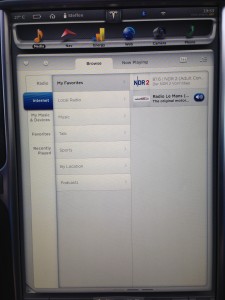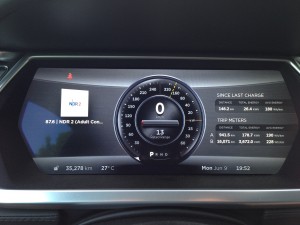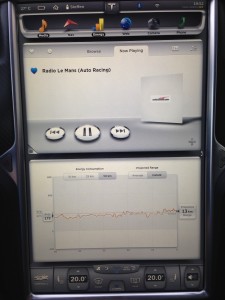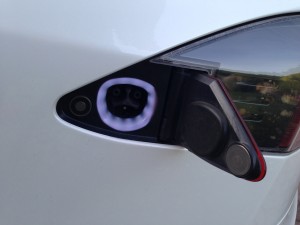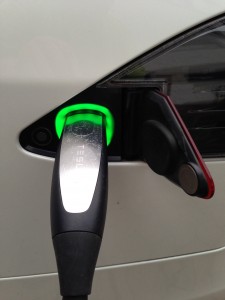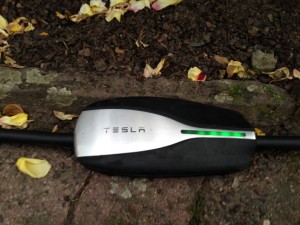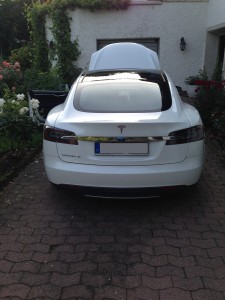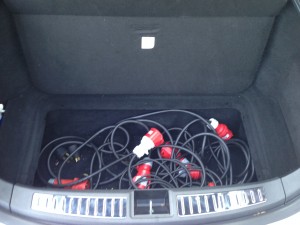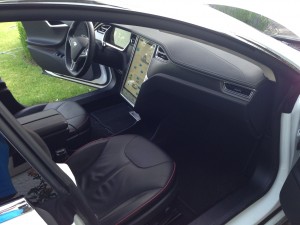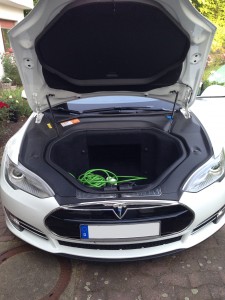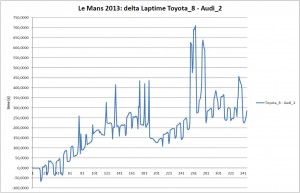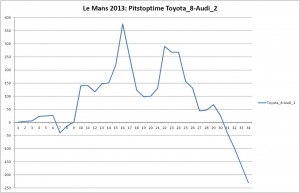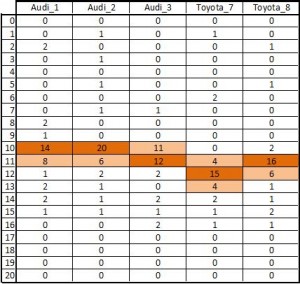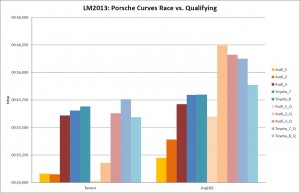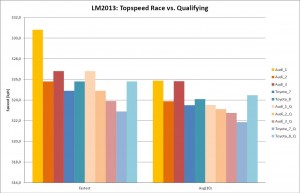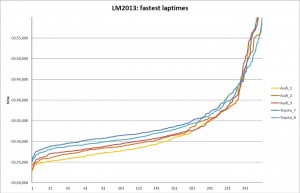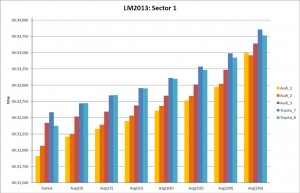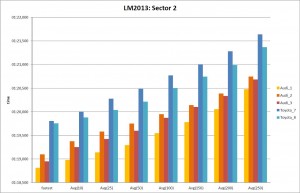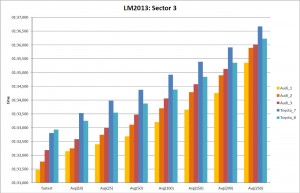1100km im Tesla Model S
Ich hatte die Chance für einige Tage einen Tesla Model S fahren zu dürfen. Die Vorfreude war groß, schließlich liest und hört man sehr viel Gutes über das Auto. 500km Reichweite bei konstant 88km/h, 600Nm Drehmoment ab 0 Drehzahl, 320kW Leistung, dazu das riesige Display in der Mittelkonsole und sowieso alles im „iPhone-Style“.
viel Gutes über das Auto. 500km Reichweite bei konstant 88km/h, 600Nm Drehmoment ab 0 Drehzahl, 320kW Leistung, dazu das riesige Display in der Mittelkonsole und sowieso alles im „iPhone-Style“.
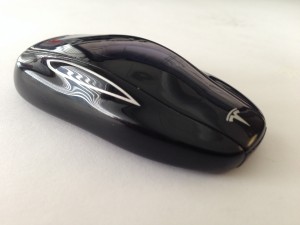
Im Vorfeld habe ich mir viele Gedanken gemacht wohin könnte ich denn fahren, wie weit kann ich real fahren und welche Ladepunkte kommen in Betracht. Vor allem letzteres wurde natürlich interessant, da sich das Fahrzeug durch einen Schwachpunkt auszeichnet: es ist ein US-Modell.
Damit kann ich nur einphasig, statt dreiphasig laden und der Tesla Supercharger war auch nicht verwendbar. Aber gut geplant ist die halbe Miete.
Ziel wurde schnell klar: Fanø, da ich hier sowieso gerne und oft hinfahre. Außerdem kann man einen Großteil der Strecke über Land fahren und es liegen einige Ladestationen in interessanter Lage auf’m Weg.
Die Route sollte von Wolfsburg über Land bis nach Uelzen und Lüneburg erfolgen und von dort auf der A39 und A7 bis rauf zur Grenze. Vorher abfahren und quer rüber nach Tønder. Aufgrund der Informationen, die man so erhält habe ich gehofft 450km am Stück fahren zu können. Dazu wollte der Tempomat auf den Landstraßen auf 80 und auf der Autobahn auf 100 eingerastet sein. Sollte sich zeigen, dass der Wagen „gut im Saft“ steht, wollte ich das Tempo etwas erhöhen.
Um 3:40 Uhr Samstag morgens ging es los. Der Wagen war vollgeladen und alle Verbraucher auf ein Minimum reduziert.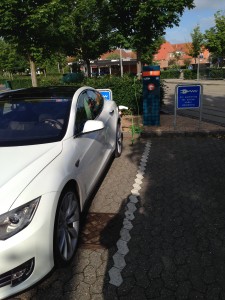
Obwohl konsequent durchgezogen, ohne Zwischenspurts oder Überholmanöver, war das Ergebnis etwas ernüchternd – ernüchternd relativ zu der erhofften Reichweite. 367km mit 30km Restreichweite. Dazu eine Fahrzeit von fast 5 Stunden. Die Ladesäule von Clever A/S war schnell gefunden und dank der vorher bestellten RFID Karte konnte der Ladevorgang auch gleich starten. Die Ladesäule liegt auf einem Parkplatz mit Zugang zur sehr schönen Fußgängerzone. Überhaupt handelt es sich um einen sehr schönen und angenehmen Ort und nach einem kleinen Rundgang hat der örtliche Bäcker für ein schönes Frühstück gesorgt. Inzwischen öffneten die Läden und wir konnten auch so noch etwas Zeit totschlagen – im positiven Sinn, denn Tønder hat Lust auf einen erneuten Besuch gemacht!
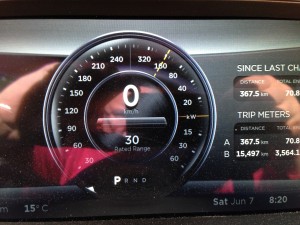 Nach 2,5h und weiteren 90km im Tank ging es dann weiter Richtung Norden. Obwohl gar nicht notwendig, hielten wir noch in Ribe, da auch dieser Ort sehr schön sein soll und hier wieder ein Parkplatz mit 4 Ladepunkten zur Verfügung stand. Natürlich war ein Platz von einem nicht elektrischen belegt. Auch von diesem Punkt ist es nicht weit in die Innenstadt, eigentlich auch sehr schön, jedoch an diesem Vormittag total überlaufen, weshalb wir nach einer halben Stunde den Rückweg angetreten sind.
Nach 2,5h und weiteren 90km im Tank ging es dann weiter Richtung Norden. Obwohl gar nicht notwendig, hielten wir noch in Ribe, da auch dieser Ort sehr schön sein soll und hier wieder ein Parkplatz mit 4 Ladepunkten zur Verfügung stand. Natürlich war ein Platz von einem nicht elektrischen belegt. Auch von diesem Punkt ist es nicht weit in die Innenstadt, eigentlich auch sehr schön, jedoch an diesem Vormittag total überlaufen, weshalb wir nach einer halben Stunde den Rückweg angetreten sind.
Die Fahrt nach Fanø war dann auch noch schnell hinter uns und nach rund 10h waren wir am Ziel. Selbst ohne die letzte Pause in Ribe und Minimalhalt in Tønder wären es 9h gewesen – für eine Fahrt, die wir sonst in 4-4,5h zurücklegen.
Dazu kam, dass ich auf Fanø auch laden musste. Die Idee war, jemanden zu finden, der eine CEE32A Drehstromdose hat. Dank der Hilfe eines Freundes hat sich dann auch jemand gefunden, jedoch stellt sich dann am Samstag Nachmittag heraus, dass es nur eine CEE16A Dose gewesen ist. Und da der Wagen, im Gegensatz zum EU-Modell, nur mit einer Phase laden kann, dauerte es mal eben 24h.
Also war der Plan den Wagen voll zuladen und dann die fehlende Reichweite in der Nacht zu Montag auf dem Platz an einer Schuko-Dose aufzufüllen.
 Auch hier wieder ein Highlight erlebt: der Platz war elektrisch so schlecht konzipiert, dass der bei nur 5A Ladestrom, die Spannung auf 202V zusammengebrochen ist. 1kW Ladestrom… das ist für eine 85kWh Batterie sehr wenig. Aber es hat gereicht und am nächsten Tag war der Wagen voll – bereit für die Rückfahrt.
Auch hier wieder ein Highlight erlebt: der Platz war elektrisch so schlecht konzipiert, dass der bei nur 5A Ladestrom, die Spannung auf 202V zusammengebrochen ist. 1kW Ladestrom… das ist für eine 85kWh Batterie sehr wenig. Aber es hat gereicht und am nächsten Tag war der Wagen voll – bereit für die Rückfahrt.
Die Strategie war die gleiche wie zuvor bei der Hinfahrt: 80km/h auf der Landstraße und 100km/h auf der Autobahn. Geplanter Zwischenhalt in Winsen(Luhe). Da es jedoch sehr heiß war und wir erst mittags übersetzen konnten, mussten wir mit der Klimaanlage fahren.
Überraschenderweise hielt sich im Eco-Modus der zusätzliche Verbrauch in Grenzen und wir kamen mit 90km Restreichweite in Winsen an. 144 km hatten wir zu fahren, also wollte ich mindesten 160km auf dem Zähler haben. 70km nachladen bedeutet rund 2h Zeit…Mittag gab es nicht, also zufällig gleich um die Ecke ein nettes Lokal gefunden und die Zeit mit Essen totgeschlagen. Hier war es aufgrund der Hitze und vor allem der Schwüle wirklich ein unangenehmes totschlagen, bevor es dann endlich heimwärts ging.
Mit 13km Restreichweite rollten wir auf den Hof – nach rund 8,5h
Die Ladestationen in Dänemark und in Winsen waren von der Lage schon sehr gut. Sehr zentral und unweit von Fußgängerzonen, Lokalen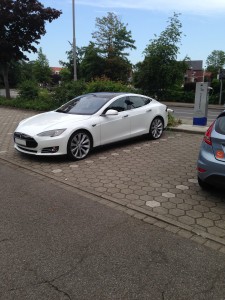 und Geschäften. Jedoch hatten wir in Winsen ein komisches Gefühl bei dem Publikum, das dort herumlief und eigentlich mochte man sein Auto da nicht abstellen. Es mag ein falscher und auf alle Fälle subjektiver Eindruck sein, da man aber nach solchen Einflüssen seine Entscheidungen trifft, wollte ich es nicht unerwähnt lassen.
und Geschäften. Jedoch hatten wir in Winsen ein komisches Gefühl bei dem Publikum, das dort herumlief und eigentlich mochte man sein Auto da nicht abstellen. Es mag ein falscher und auf alle Fälle subjektiver Eindruck sein, da man aber nach solchen Einflüssen seine Entscheidungen trifft, wollte ich es nicht unerwähnt lassen.
Sehr interessant waren auch die Reaktionen der Leute. Von Tesla haben schon viele gehört und verbinden es mit dem Begriff „Elektroauto“, aber gesehen haben es de wenigstens, sind baff erstaunt, dass sowohl vorne, als auch hinten sehr große Kofferräume sind, fragen wo denn die Batterie sei und wenn der Monitor in Blick kommt, hat das Staunen kein Ende. Positiv überrascht sind die Leute über die Reichweite und auch über die Ladezeiten(eines EU-Modells) speziell am Supercharger.
Tja und wie fährt sich das Auto?
Der Schub von 600Nm ist gigantisch, wenn man wirklich mal auf den Pinsel drückt, dann drückt es die 2,1t richtig voran. Vor allem ist die Reaktion auf die Gaspedalbewegung instantan, es ist unvergleichbar mit Otto- oder Dieselantrieben. Eine Gedenksekunde gibt es einfach nicht. Aber auch das Verzögern hat eine neue Dimension bekommen. Der Wagen kann im Normalfall bis zu 60kW Verzögerungsleistung erbringen. Das reicht aus um fast immer ohne Bremspedal zu fahren und nur mit dem Gaspedal die Stärke der Verzögerung zu modellieren. So habe ich auf Fahrt gen Norden nur zweimal die mechanische Bremse verwendet – alles andere lief elektrisch. Steigt man in einen normalen PKW um, merkt man sofort, dass das etwas anders ist.
Das zentrale Display in der Mitte ist der Hammer! Top Auflösung und einfache Bedienung im Smartphone-Stil. So sehr es mir gefällt, so sehr lehne ich es an einigen Stellen auch ab. Denn einige Dinge würde ich gerne blind bedienen wollen mit klassischen Schaltern – zum Beispiel die Klimaanlage oder das Fahrlicht. Man muss doch immer auf das Display schauen wo man hin tippt und das lenkt ab.
Aufgrund der US-Version funktioniert zwar Google Maps, jedoch ohne Navigationsfunktion (warum auch immer) und das Radio war im amerikanischen 200kHz Raster und konnte nur Stationen mit ungerade Nachkommastelle finden. Dazu noch mit einem recht schlechten Empfang, ohne RDS und XM Satellite funktioniert in Europa nicht. Internet gab es nur über den Umweg eines lokalen Hotspots der im Auto verbaut wurde. Das Bluetooth Handling mit dem iPhone funktionierte leider auch nicht sauber und brach ab und zu ab. Sitze haben eine zu kurze Beinauflage, der Einstieg hat eine komische Kante an der B-Säule, die schon ganz abgewetzt ist. Außerdem sind ein paar Materialien einfach billig gelöst. Hutablage oder der Deckel für das Fach im Kofferraum. Und die Beding des Tempomaten, Übernahmeteil von Daimler, ist genauso rätselhaft wie beim Daimler. Apropos Tempomat: die schnelle Reaktion des E-Antriebes hat auch seine Nachteile. Wirft man den Tempomaten auf Knopfdruck ab, haut es einen gleich mal in den Gurt. Da muss man mit dem Gasfuss etwas „vorspannen“ um dann einen sanften Übergang zu schaffen.
Wie fällt mein Fazit aus?
Für ein Erstlingswerk ist der Tesla Model S ein sehr beeindruckendes Fahrzeug mit ein paar Schwächen hier und da, aber alles in allem positiv. Die Reichweite beeindruckt und das Fahrzeug ist nicht umsonst der Benchmark. Wenn Tesla aus all den Kleinigkeiten lernt, wird der Nachfolger sicher ein Hammer.
Die EU-Version hätte sicherlich einen noch besseren Eindruck hinterlassen, aber das war abzusehen.

